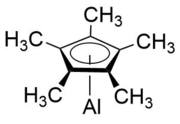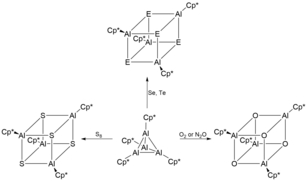(Pentamethylcyclopentadienyl)aluminium(I)

| |
| Names | |
|---|---|
| Other names
AlCp*, Cp*Al
| |
| Identifiers | |
| |
| Properties | |
| C10H15Al | |
| Molar mass | 162.212 g·mol−1 |
Except where otherwise noted, data are given for materials in their standard state (at 25 °C [77 °F], 100 kPa).
| |
(Pentamethylcyclopentadienyl)aluminium(I) is an organometallic compound with the formula Al(C5Me5) ("Me" is a methyl group; CH3). The compound is often abbreviated to AlCp* or Cp*Al, where Cp* is the pentamethylcyclopentadienide anion (C5Me5−). Discovered in 1991 by Dohmeier et al.,[1] AlCp* serves as the first ever documented example of a room temperature stable monovalent aluminium compound. In its isolated form, Cp*Al exists as the tetramer [Cp*Al]4, and is a yellow crystal that decomposes at temperatures above 100 °C but also sublimes at temperatures above 140 °C.[1][2]
Synthesis
The earliest documented synthesis and characterization of Cp*Al was by Dohmeier et al. in 1991,[1] where four equivalents of AlCl in toluene/diethyl ether is reacted with two equivalents of 2[Mg(Cp*)2] to give [Cp*Al]4 as yellow crystals:

Despite the above synthetic scheme successfully producing tetrameters of [Cp*Al]4 at reasonable yields (44%), its use of AlCl proved problematic, as AlCl synthesis requires harsh conditions and its reactive nature makes storage a challenge. As such, more facile ways of synthesising the [Cp*Al]4 tetramer were discovered, and required the reduction of Cp*AlX2 (X = Cl, Br, I) by a metal (K when X = Cl) or a metal alloy (Na/K alloys when X = Br, I):[3][4][5][6][7]

More exotic ways of synthesizing [Cp*Al]4 include the controlled disproportionation of an Al(II) dialane into constituent Al(I) and Al(III) products. For example, reacting dialane [Cp*AlBr]2 with a Lewis base such as pyridine the Lewis base stabilized [Cp*AlBr2] and [Cp*Al]4.[8]
Monomeric Cp*Al has also been isolated in a solid Ar matrix by heating [Cp*Al]4 in toluene to 133 °C and spraying the resultant vapours with Ar onto a copper block kept at 12 K.[9]
Structure and bonding
X-ray crystallographic data determined Cp*Al to exist exclusively as a tetramer in its solid state. This tetramer, [Cp*Al]4, consists of an Al4 tetrahedron, and the Cp* rings are ŋ5-coordinated to the aluminium(I) cation such that the planes of the C5Me5- rings are approximately parallel to the opposite base of the Al4 tetrahedron.[1] The perpendicular distance between Al and the Cp* ring was determined through crystallography to range from 199.7 to 203.2 pm, with a mean value of 201.5 pm.[1] The Al-Al bond in [Cp*Al]4 is 276.9 pm, which is slightly shorter than that of metallic aluminium, which has an Al-Al bond length of 286 pm.[1] Additionally, the Al-Al bond in [Cp*Al]4 is significantly shorter than other oligomeric and polymeric Group III M(I)-ŋ5-Cp* compounds such as octahedral [InCp*]6 (394, 336 pm), dimeric [InCp*]2 (363.1 pm), and polymeric [TlCp*] (641 pm), indicating a significantly larger interaction between aluminium atoms in [Cp*Al]4 than monovalent Cp* compounds of In(I) and Tl(I).[3] Additional characterization that has been performed include Raman spectroscopy, which detected a Raman active breathing vibration (A1, 377 cm-1) of the Al4 tetrahedron in [Cp*Al]4.[1]
Despite its typically tetrameric form, the monomer Cp*Al has been isolated and studied in the gas-phase using gas-phase electron diffraction. In its gaseous monomeric form, the perpendicular distance between the Al to the Cp* ring was calculated to be 206.3(8) pm, which is slightly longer than tetrameric [Cp*Al]4.[2]
Reactivity
When isolated in a solid H2 doped Ar matrix, monomeric Cp*Al has shown to form the hydride species H2Cp*Al upon exposure to H2 and photolysis with a Hg lamp:[9]

At temperatures above 100 °C, [Cp*Al]4 decomposes to form pentamethylcyclopentandiene (Cp*H), metallic aluminium (Al(0)) and other non-volatile Al(III) compounds.[2] The overall stability of [Cp*Al]4 is unique as there is a thermodynamic affinity for tetrameric aluminium(I) compounds ([RAl]4) to disproportionate into elemental aluminium and R3Al. As such, a number of different novel oligomeric structures can be synthesised when using tetrameric [Cp*Al]4 as a precursor.[6] For example, treatment of [Cp*Al]4 with excess selenium and tellurium in mild conditions gives the unique heterocubane structures [Cp*AlSe]4 and [Cp*AlTe]4 respectively.[4] These heterocubane structures are extremely air and moisture sensitive, leading to its decomposition and evolution of H2Se and H2Te respectively. Analogously, reaction of [Cp*Al]4 with lighter chalcogens such as O2, N2O and sulfur yield [Cp*AlX]4 (X = O, S).[12]

[Cp*Al]4 was also the used as a precursor to synthesize the first ever stable dimeric iminoalane containing an Al2N2 heterocycle through the treatment of [Cp*Al]4 with Me3SiN3 in a 1:4 molar ratio.[13] The resultant iminoalanes was characterized to contain an ideally planar Al2N2 core ring with three coordinate aluminium and nitrogen atoms. Other dimeric iminoalanes including [Cp*AlNSi(i-Pr)3]2, [Cp*AlNSiPh3]2 and [Cp*AlNSi(t-Bu)3]2 have since been synthesized using [Cp*Al]4 as a precursor through oxidative addition of an organic azide.[3]

Function as a ligand

[Cp*Al] is able to act as an atypical exotic
[Cp*Al] is also able to act as a potent ligand to transition metals. For example, treatment of [Cp*Al] with [(dcpe)Pt(H)(CH2t-Bu)] (dcpe = bis(dicyclohexylphosphino)ethane) yields [(dcpe)Pt(Cp*Al)2].[17] Other transition metals which use [Cp*Al] as a ligand include, but are not limited to d10 metal centre complexes such as [Pd(Cp*Al)4] and [Ni(Cp*Al)4],[18] and lanthanide/actinide metal centre complexes such as (CpSiMe3)3U-AlCp*, (CpSiMe3)3Nd-AlCp* and (CpSiMe3)3Ce-AlCp*.[3][19]

References
- ^ ISSN 0570-0833.
- ^ ISSN 0276-7333.
- ^ S2CID 105749253.
- ^ ISSN 0570-0833.
- ISSN 0022-4596.
- ^ ISSN 0276-7333.
- PMID 18758620.
- S2CID 49308900.
- ^ ISSN 0276-7333.
- S2CID 2992445.
- ^ PMID 26171664.
- PMID 27129027.
- ISSN 0570-0833.
- ISSN 0002-7863.
- ISSN 1359-7345.
- ^ ISSN 0276-7333.
- ISSN 0276-7333.
- ISSN 0044-2313.
- PMID 19725526.
